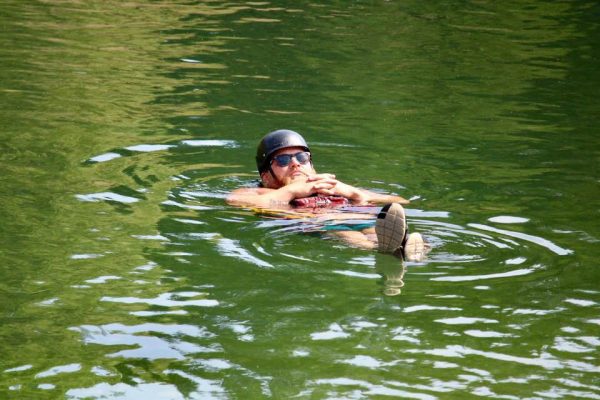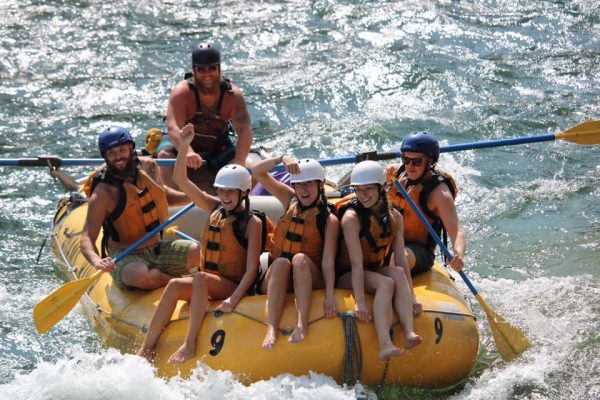 By Will Johnson
By Will Johnson
Shortly after losing a job in November 2017, an event which led to an escalating series of manic episodes, I ended up in the psych ward of Vancouver General Hospital. They informed me that my antidepressant was partially to blame for my uncharacteristic behaviour, then gave me a prescription for lithium — a drug I’d only ever associated with Kurt Cobain, the Nirvana frontman who took his own life with a shotgun. I understood that I would have to do something drastic if I wanted to regain a level headspace and a sense of normalcy.
Stewing in my parents’ basement for a number of months, painting and wasting time on social media, I could feel my body swelling from the inactivity. My depression was coming back with a vengeance and I knew I needed something to distract and engage me, ideally some sort of endeavour that was physically demanding and could bring me closer to the fitness level I’d enjoyed as a competitive swimmer in high school. I needed something that touched on all the fundamental aspects of physical literacy: competence, confidence, motivation, knowledge and understanding. Going for a jog every once in a while wasn’t going to cut it.
Most jobs wouldn’t give me this, though, and the majority of the opportunities I looked up involved being sedentary at a desk for 40 hours a week — a recipe for disaster, I figured. That’s when whitewater rafting occurred to me. As a teenager I’d rafted the Thompson River in Lytton, the third largest commercially rafted river in the world, and I’d long fantasized about becoming a guide like the charismatic foreigners who had piloted my rafts decades before. From the age of 17 through 27 I’d planned to enroll in guide school each summer, but I always found some excuse not to: a new job, a new girlfriend, lack of money. Now suddenly I found myself with no conflicts, and no reason not to jump at this chance. I called up one of the owners of Kumsheen Whitewater Rafting, Braden Fandrich, and put down a deposit to hold my spot. I was 33 years old and ready for a new profession.
When all was said and done, I ended up developing my competence by rafting six different rivers over the course of the 12 gruelling days of guide school. Not only did I learn proper oar and paddle techniques, I also picked up knot-tying skills, became an expert at tossing rescue throw-bags, and experienced swimming through roiling rapids. Though I was significantly out of shape, I went in confident that the aquatic skills I’d developed as a kid would serve me. As it turned out, though, the rivers absolutely kicked my ass on more than one occasion. I found myself more and more feeling an unfamiliar sensation: fear.

That’s when Braden gave us a little speech.
“There’s something I’ve learned with rafting, and I guess it’s the same with other extreme sports but it’s especially true of being on the river — when things get scary or overwhelming, it really gives you an opportunity to either let that fear make you weak, or let it make you stronger,” he said.
He held his paddle in his lap, calmly sitting there in his dry suit as we drifted down the Nicola. “I guess what I’m saying is, choose to let it make you stronger.”
This was the first major skill I learned that would be pertinent to my outside life: fear management. This fell under one of the most important aspects of physical literacy, confidence, and it bled out into my everyday existence. And once I was hired that summer at Adams River Rafting in Scotch Creek, doing an hour-long course that involved a Class 3 rapid called the Canyon, I became well-versed at recognizing the moments when I was afraid and funnelling that energy in a productive direction.
By this point I was working on developing two other aspects of physical literacy, knowledge and understanding. I talked through the play-by-play of that same 35-second stretch with my boss Clif Garcia multiple times, discussing how to negotiate each hit and how to compensate for all the forces outside my control. Repeatedly I found myself facing down waves that I thought would absolutely wreck me, and each time I took a deep breath and made the most of it.
When it comes right down to it, water is just water, and making it successfully down the river has more to do with your composure than the actual mechanics of all that surging H20.
By the end of the summer, I had navigated the Adams River nearly 100 times. I watched my skin darken, my hair bleach and the pounds drop away. It wasn’t just the time on the water that was keeping me fit; there were also the mundane tasks like lifting the rafts on and off the trailer, hiking up the canyon wall to lead clients in a cliff jump, and bending over the side of the raft to grab ahold of clients by the lifejacket and heave them back into my boat. My energy surged, my depression faded, and I felt a growing pride in my newfound skill set. I was legitimately good at something, and thinking about that felt better than fixating on the series of mistakes I’d made in the months before. I had developed the motivation to become the best guide I could possibly be.
The other thing is that I was bringing people joy, and that brought me joy. Every day when I loaded my boat with new clients I saw faces ranging in age from five years old to 90, from all sorts of backgrounds. Some could swim, some didn’t even know how to paddle. Twice I shared a raft with Paralympian Josh Dueck, another time I went down the river with hockey star Shane Doan and his family. One trip would be a group of co-workers, the next would be a bunch of camp kids. Sometimes we made adjustments, such as when one of my clients didn’t have a left hand and needed to switch sides, but we always figured out a way to make things work. If you were game to come down the river, we were game to take you.
After the summer was over I took a storytelling position at Sport for Life, intrigued by this new term “physical literacy”. Though I was initially skeptical, I eventually became a full convert via writing about the various success stories and triumphs we’ve experienced as a non-profit. Lives were being changed for the better, whether that meant a field hockey team tweaking their inclusion practices, some government adopting an active living mandate or a hockey program embracing the tenets of Long-Term Development in Sport and Physical Activity. What I was most impressed by was Sport for Life’s commitment to walking their talk, ensuring the workforce is diverse and introducing things like standing desks and walking meetings. They were looking to change the culture and that started right in our office.
In our flagship publication Developing Physical Literacy: A New Normal for all Canadians, Sport for Life lays out a game plan for how to address the physical inactivity crisis. It’s a multi-faceted enterprise, with varying implications for different age groups and populations, and it requires large-scale buy-in. Ultimately, the aim is to have physical literacy mentioned in the same breath as numeracy and literacy, and to have it prioritized in the same way. When it comes to mental health, according to research done by experts like Dr. Guy Faulkner at UBC, there is growing evidence that physical activity may play an important role in the prevention of mental health problems like depression and anxiety. It also notes that exercise and physical activity are now recommended as first-line therapies in the treatment of mild to moderate depression.
 So when it came time for the rafting season to return, I knew which approach to take when asking for time off: I wrote my bosses an email, explaining that returning to my raft gig for the summer would be “a crucial part of my physical literacy journey”. I was being slightly facetious, but also dead serious. In Victoria I’d struggled to find regular fitness opportunities, and multiple times I had to give up my CrossFit membership because I couldn’t afford it. I had regained the weight I’d lost the previous summer, and I could feel my depression rearing its ugly head. It had been coiled in the shadowy corners of my mind, waiting patiently.
So when it came time for the rafting season to return, I knew which approach to take when asking for time off: I wrote my bosses an email, explaining that returning to my raft gig for the summer would be “a crucial part of my physical literacy journey”. I was being slightly facetious, but also dead serious. In Victoria I’d struggled to find regular fitness opportunities, and multiple times I had to give up my CrossFit membership because I couldn’t afford it. I had regained the weight I’d lost the previous summer, and I could feel my depression rearing its ugly head. It had been coiled in the shadowy corners of my mind, waiting patiently.
But the moment I got on to the river again this past summer all of that angst wafted off into the sky. I was in my element again, joshing with the customers and making up tall tales. It felt like having my own personal watery highway as I commandeered my bright yellow boat around each bend. I practiced each maneuver over and over, waking up my arms from their eight-month slumber, and relished every moment of crashing through the Canyon. I wasn’t afraid anymore; I was having the time of my life. Afterwards I would stand hip-deep in the river and take deep nostril-shots of forest air while the clients hung out on the beach, reminding myself repeatedly how lucky I was to be there.
Sometimes saving someone’s life is less dramatic than rescuing them from a burning building. Sometimes it’s as simple as teaching them how to properly climb back into a raft without assistance, or how to tie all the knots and deploy all the necessary carabiners to complete a Z-drag pulley system. Maybe it’s as simple as giving them a job, then telling them to do it. Imagine a physical literacy-based mental health system that prescribed a dose of whitewater rafting to patients feeling lost, suicidal or hopeless. The prescription would say “River Time – Min: Two Summers”, and would come with a paddle.
It worked for me.
For more information about our Developing Physical Literacy: A New Normal for All Canadians resource, please contact tyler@sportforlife.ca.
